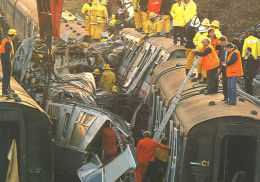Posted 12th December 2008 | No Comments
The disaster which changed safety on the railway

Above: The scene on the morning of Monday 12 December 1988.
TWENTY years ago today the Clapham rail crash became the worst rail crash on the railway for 21 years.
The death toll of 35 people – two of them train drivers -with 500 people injured, 69 of them seriously, sent shock waves throughout the railway industry and was to fundamentally change the way in which is safety is managed on the railway.
The accident happened at 08.10 on the morning of Monday 12 December 1988 in a deep cutting just south west of Clapham Junction station, one of the busiest junction stations in Britain.
A train packed with 468 early morning commuters from Poole crashed into the rear of a stationary train from Basingstoke carrying 906 people.
The force of the impact sent the Poole train into the path of an empty Haslemere train travelling in the opposite direction.
The cause of the disaster was the failure of signal WF 138 to protect the stationary Basingstoke train, which had been brought to a halt after the signal changed from green to red as it was passed.
A report into the crash, following a 56-day public inquiry chaired by Sir Anthony Hidden QC, was heavily critical of working methods used during the Waterloo Area Resignalling Scheme.
A total of 71 recommendations were made in the report, many of which emerged from the way in which the new signalling on the scheme had been installed, tested and audited at the time.
A senior technician responsible for the wiring error at Clapham ‘A’ box had worked for 13 weeks with only one day off.
Hidden recommended sweeping changes in installation methods, tighter control over design offices, independent testing of work, the recruitment of sufficient numbers of suitably qualified people, better training, and an end to excessive working.
The signal works testing handbook was developed to lay down mandatory procedures and processes to be used in testing new signalling – the handbook is a railway group standard.
Hidden also called on British Rail to bring in ATP – Automatic Train Protection – for the whole mainline network in five years which would have been 1994.
Two systems were installed and piloted on the Chiltern Line and the Great Western main line but later in the 1990s Railtrack developed TPWS, Train Protection and Warning System, which the company said provided 90 per cent of the protection of ATP at 10 per cent of the cost.
TPWS is now credited with playing a major part in reducing the number of Spads – signals passed at danger – on the rail network and this year Network Rail is trialing part of ERTMS, the European Railway Traffic Management System, on the Cambrian Line.
This trial stems from the findings of the inquiry into the Ladbroke Grove train crash on 5 October 1999.
